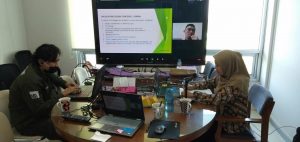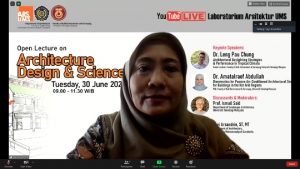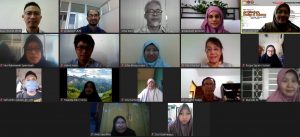*Author: Hafsah Intifadhoh Rabbaniyah
Department of Architecture, Faculty of Engineering, Universitas Muhammadiyah Surakarta in collaboration with the Faculty of Built Environment and Surveying, Universiti Teknologi Malaysia held an architecture Open Lecture that talk about interesting themes in each meeting. On Thursday 30 June 2020, the second Open Lecture was held with the theme “Architecture Design & Science” and invited two speakers from the Faculty of Built Environment and Surveying, University of Technology Malaysia. This activity which took place from 09.00-11.30 WIB with virtual meeting can be accessed through zoom meeting and live streaming on Laboratorium Arsitektur UMS youtube channel. This Open Lecture was moderated by Yayi Arsandrie, S.T., M.T. who is a lecturer from Universitas Muhammadiyah Surakarta and Prof. Ismail Said who came from the Department of Landscape Architecture, Universiti Teknologi Malaysia, as a discussant in the Open Lecture session this time. The total number of participants who took part in this activity counted to be above 50 participants consisting of students, fresh graduates, and teaching staff who incidentally came from various universities in Indonesia, Malaysia and Singapore.


The first presentation of this Open Lecture was delivered by Dr. Leng Pau Chung, a Senior lecturer from the Faculty of Built Environment and Surveying, Universiti Teknologi Malaysia. Discussed about “Architectural Daylighting Strategies & Performance in Tropical Climate”, Dr. Leng Pau Chung, who is familiarly called Dr. PC, outlined some important points such as: (1) increasing the energy efficiency used by minimizing the use of electrical energy for lighting and reducing heat with passive design; (2) natural lighting also has an important role in the issues of global warming, carbon emissions, and sustainable architectural design, which on the other hand, natural lighting participates in influencing human behavior, health and the resulting productivity; (3) procurement of windows as natural lighting paths can provide views that result in user interaction with the outside of the room. At the end of the explanation, Dr. The PC includes examples of case studies derived from the accumulation of his student guidance assignments. Beside that, Dr. PC also provides several design tools and methodology that can be used in designing aspects of natural lighting.The second speaker also came from the Faculty of Build Environment & Surveying, Universiti Teknologi Malaysia, namely Dr. Amatalraof Abdullah delivered a topic on “Biomimetics for Passive Air Conditioned Design for Buildings in the Hot Arid Regions”. In short, Dr. Amatalraof presented about how biomimicry innovation inspired by the nature. The discussion is carried out in detail from the background, research problems, urgency of the topic, research methodology, results and conclusions from related research. This research departs from issues relating to indoor overheating in the hot arid regions, which reduce the level of productivity and decision making, health problems and massive use of electricity which certainly has its own impact on environmental damage and climate on earth. Furthermore, Dr. Amatalraof explains how living things in nature defend themselves from hot environments by using the following strategies: (1) evaporative cooling through nasal turbines; (2) radiative cooling through thermal radiator; (3) convective cooling through air circulation. These strategies were then used by Dr. Amatalraof as a concept in designing buildings in hot areas.


After the explanation given by the two speakers finished, the second open lecture was followed by a brief presentation by Prof. Ismail Said related to the theme talked about and ended with question and answer between the participants and the two speakers. This open lecture can be accessed also from Laboratorium Arsitektur UMS Youtube channel or from this following link: https://www.youtube.com/watch?v=6rwVdgfE5qs
